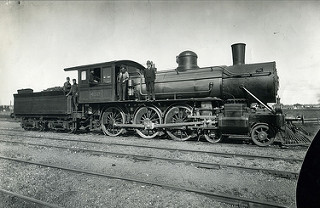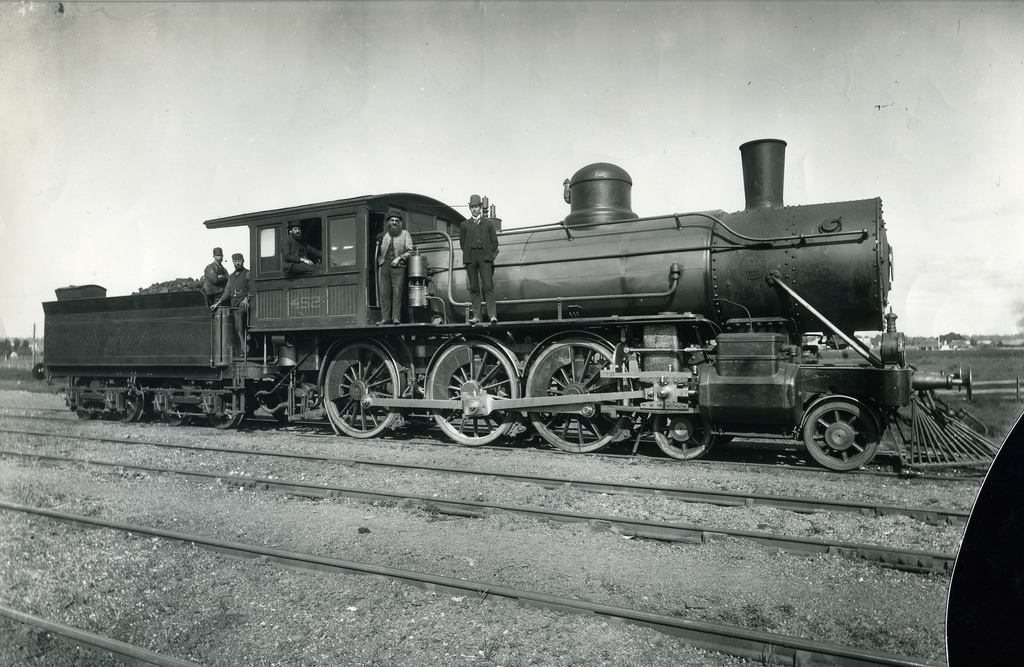Baldwin 4-6-0 Locomotive
No 452 was part of a batch of 12 imported from Philadelphia in 1891, at a price of $US15,000 each, they arrived less than seven months after contract signing, being designated class 0466.
The engines were ruggedly impressive in the pattern of earlier Baldwins, being larger, having a higher tractive effort than any iron horse before them. Seeming to ooze with power, they came with stovepipe stacks, aggressive drumhead smokeboxes, the deafening bullroarer whistle and loud exhaust beat. Together they continued that peculiar American practice of locating the large cab astride the boiler so that driver and fireman sat on opposite sides of the backhead (positions which were known around the sheds as the "living-room" and the "kitchen"). A forward door aided ventilation of the cab and enabled the fireman to venture with his tallow kettle along the running plate; but to feed the firebox he was required to place himself in the pitching gangway between engine and tender with full exposure to the elements — no wonder they called them iron men!
The 0466 was New South Wales' first ten-wheeler. On Western line trains they eliminated the uneconomic "assistant engine" practice; The Fish was now run with a single Baldwin and the schedule cut by fifteen minutes between Penrith and Wentworth Falls. Loads taken by the Big J, most of them stationed at Penrith shed, went up to 270 tons unassisted over the mountains. Frank Hurley, the Australian photographer later renowned for his camera craft in Antarctica and the Western Front, captured the J483's, to quote their official class, in some of his early postcards as they lumbered from Blue Mountain tunnels. They had almost 30 per cent more tractive effort than any existing engine and were the first in New South Wales to exceed 100 tons weight; in every respect they smacked of toughness, brute force — because of the large grates, sometimes they were known as "the coal chewers".
Two of the J's were landed as compound engines on the Vauclain principle of steam exhausted from the smaller high pressure cylinder immediately being reused in the larger, low pressure chamber above it. Both pistons then drove a common crosshead. The Vauclain system — Sam Vauclain was Baldwin's Works Manager — appears to have given more trouble than performance and within five years the engines were modified to conform with the simple cylinder type.
Despite that grand entrance, the Baldwin critics were about to have a field day. The Philadelphia engines had never lacked opponents, especially among those who held that only the British produced locomotives of quality and endurance. Now, shortly after entering traffic, things began to go wrong. Tender wheels broke, axles failed, tyres proved defective. Though Baldwin quickly replaced the parts, faulty iron castings used in the axles being judged the chief culprit, those who savoured a scandal went on to allege that the hastily purchased engines were far too rough, too heavy and bulky for the permanent way of New South Wales; as well they caused needless money to be spent on cutting back station awnings and reducing platform edges.
A Royal Commission resulted. Much evidence was taken, many wild assertions heard and a certain amount of acrimony flared up again from combatants of the long v short driving wheelbase debate. Clearly there was a clash between the views of Thow and the now retired Midelton. The Commission found that the Americans were not failures. In the report of July 19, 1892, it said the Baldwin engines "were not unsuited to the permanent way of the colony . . . and were not defective in design. The objectionable tyres and axles have been replaced by others of approved quality, and there is no reason to doubt that they will be capable of rendering the service which was expected of them."
By the mid-1890's the P6 and the Standard goods began to arrive in increasing numbers. They would eventually be the work horses of the Blue Mountains line. Now the days of shopping around for foreign designs had more or less finished (although Philadelphia itself was to deliver twenty engines of the P6 class and twelve of the identical G class for the Commonwealth). It would take another sixty years after the ordering of the O's and the Big J to find another distinctively Yankee locomotive with the Baldwin builder's plate on the New South Wales railways, once again with the haunting call of its steamboat whistle to rouse some grumbling farm hand on the edge of a clear and frosty dawn.
Reference: Full Stream Across the Mountains by Phil Belbin and David Burke 1984.
Format: Original B&W photograph
Rights Info: No known copyright restrictions
Repository: Blue Mountains City Library www.bmcc.nsw.gov.au/library/
Part of: Local Studies Collection SHS267
Provenance: Spr Hist Soc
This photo is in 7 groups
- Trove: Australia in Pictures 286,295 items
- Australian Steam Locomotives 4,408 items
- Railpage 57,124 items
- Old Trains 58,185 items
- Historic Australia 1788-1901 12,753 items
- Economic and Social History Group - People and their Industry 4,106 items
This photo is in 1 album
- Railways 24 items


la estacion del tren 6y
ChicagoGreatWestern 3y